
HPH Trust's Environmental Target
Performance Monitoring
In 2024, HPH Trust has reduced its overall emissions intensity by 1% compared to the previous year, and 26% compared to the 2021 baseline year level. The reduction was due to the adoption of a more efficient way to deploy container handling equipment, upkeep of high electric RTGC online rate, conversion of hybrid RTGCs to electric RTGCs and application of electric vehicles. Meanwhile, its estimated Scope 3 emissions for the year is 234,596 tonnes CO2e, which was a 3% increase from previous year level as a result of a surge in YANTIAN's shore power supply. The two major contributing categories remain as Category 1 – Purchased goods and services and Category 3 – Fuel- and energy-related activities. The Trust will continue to explore decarbonisation opportunities through enhancing operational efficiency, promoting the use of clean fuels in port premises, accelerating the electrification of port vehicles and equipment, and adopting other emissions-reducing initiatives across its value chain. The Trust will also seek to offset its GHG emissions through the purchase of green energy certificates. Further details on the Trust's net zero action plan will be revealed in the future.
Green Fleets at HPH Trust

Energy Saving and Emissions Reduction
Key Initiatives in 2024


HPH Trust

Notes:
- Represents the core port operation of HIT and YANTIAN.
- Scope 1 Emissions (tonne CO2e) is the GHG emissions from sources that are owned or controlled by the port.
- Scope 2 Emissions (tonne CO2e) is the GHG emissions from the generation of purchased electricity, steam, heat and cooling.
- Emissions intensity (kg CO2e/TEU), is the total of Scope 1 and Scope 2 GHG Emissions divided by the port's annual throughput.
- The emission factors applied for the calculation of Scope 1 are adopted UK Government GHG Conversion Factors for Company Reporting and USEPA's Emission Factors for Greenhouse Gas Inventories.
- The emission factors applied for the calculation of Scope 2 GHG Emissions are adopted from CLP Sustainability Report and MEE of PRC's Notice on the Announcement of Power Carbon Dioxide Emission Factor for 2022.
- To view the environmental performance of HIT and YANTIAN, please visit their respective websites.
Climate Change
With the growing visibility of climate change impacts, the Trust remains dedicated to protecting and enhancing the resilience of its assets, which is crucial for maintaining operational continuity and service delivery for partners and customers. The Trust’s approach is aligned with the four pillars recommended by the TCFD, leveraging them to analyse and disclose the risks and opportunities that climate change presents to HPH Trust’s businesses. The Trust is also preparing for the alignment with the IFRS Sustainability Reporting Disclosure Standards for the coming year’s reporting.

Understanding the company’s business portfolio can help to identify the major risks and potential impacts that may emerge. With the help of an external consultant last year, the Trust conducted assessments for climate-related risks and opportunities for the Trust’s operations. Material physical and transition risks, as well as opportunities and their potential impacts over short- (0-5 years), medium- (5-15 years), and long-term (15-30 years) horizons, were identified through a three-step process
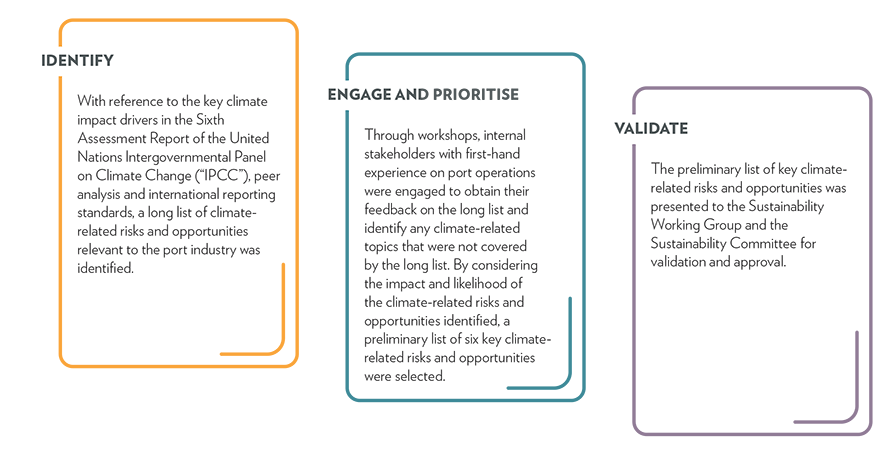
Through the three-step process, the Trust prioritised the six most significant risks based on their relevance and level of impact on the port industry and the Trust’s operations.
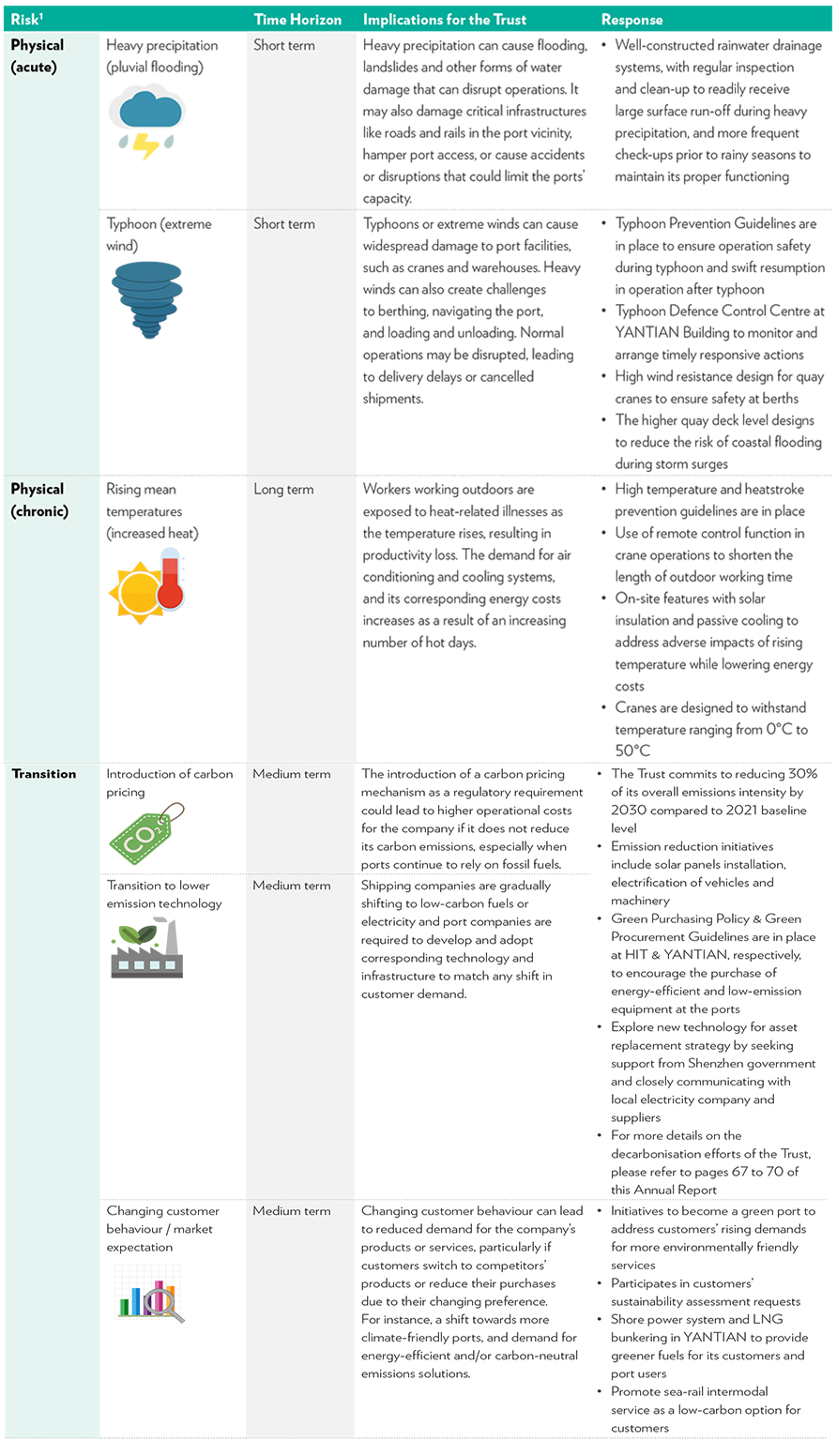
To understand exposure to the prioritised climate risks, the Trust tested the resilience of its business operations under two distinct climate scenarios associated with global temperature increases. In the scenario analysis, the Trust focused on material physical and transition risks, and referenced scenarios with climate and transition pathway projection published by reputable external bodies including Intergovernmental Panel on Climate Change (“IPCC”) and the Network for Greening the Financial System (“NGFS”).
For the physical risk analysis, historical data and projected climate variables, such as frequency of heavy rainfall, business disruption from tropical cyclones, and daily maximum temperature, were collated from suitable climate models and local meteorological data to model local climate scenarios. This model evaluates the exposure of port operations at HIT and YANTIAN to heavy precipitation (pluvial flooding), typhoon (extreme wind), and rising mean temperatures.
In conducting the transition risk analysis, various risk drivers were assessed, including the introduction of carbon pricing and fluctuating energy pricing. This assessment involved projecting carbon tax implications for port operations and estimating the electricity costs saving from transitioning to lower emission equipment. These projects were used to analyse the potential impact of transition risks on the operating expenses of the port operations.

2 The opportunity level represents a decrease in the cost impact annually, in terms of percentages in 2030 and 2050 as compared to the 2023 base year.
Water and Waste Management
The Trust adopts the 3R principles to maximise the repurposing of materials, before recycling them for further use, aiming to minimise waste generation and promote the transition to a circular economy.
Biodiversity
Please click here to view the Sustainability Performance Metrics on pages 89-97 of the latest annual report.